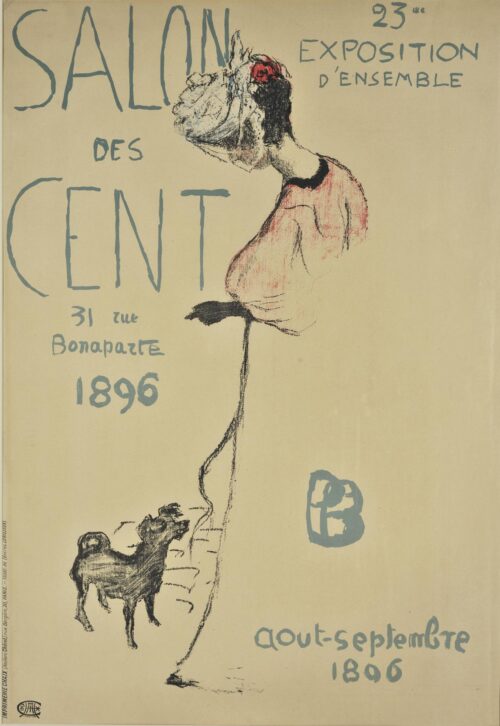
Bonnard Pierre (1867 - 1867)
“The Salon des 100”, Poster for the 23rd Group Exhibition, 1896, 1896
He studied law and while he was slated to enter the Judicature, at the same time he studied painting at the Julian Academy where he became acquainted with the Nabis group. In 1888 he was accepted at the Ecole des Beaux Arts. There he met Vuillard and they became friends. The following year he sold a lithographed poster which garnered the admiration of Toulouse-Lautrec, who followed his example. He exhibited at the Salon des Independants and with his company of friends at the Nabis. In 1896 he had his first solo exhibition at the Durand-Ruel Galllery. He had regular exhibits at this same gallery from 1904 to 1933.
Starting at an early age he had retrospectives in his honor held in various cities throughout the world. He also worked as a book and magazine illustrator. For a brief period he became involved with sculpture.
Until the end of 1909, Bonnard was deeply influenced by Japanese painting. He adopted the Japanese manner of framing prints and their placard paints. During that same period he designed various objects, costumes and stage sets for the Theatre de l’ Oeuvre.
He travelled a great deal in France and also visited Spain, Belgium, the Netherlands, England, Tunisia, Algeria and Italy. The impressions gained from these trips modified his painting and enlivened his colors. Gradually color became the primary element in his works. His subjects were taken from his everyday life and consisted by and large of nudes, still lifes and images from his home’s interior. In 1926 he lived for a time in Pittsburgh as a member of the committee for the Carnegie Prize which he himself won twice, n 1923 and 1930.
From 1930 on he used gouache to produce the intensity of color he desired.
In 1939 he settled in the village of Cannet on the Cote d’Azur and his painting became completely dominated by color. The transformation of light into color and the expression of the joy of everyday life are to be found in all his works.
Matisse admired his work and was his friend for nearly forty years. One of the most important colorists, he influenced Rothko and led him to abstraction and his work was always a point of reference for all subsequent French painters.

“The Salon des 100”, Poster for the 23rd Group Exhibition, 1896, 1896

We use cookies to make our site work properly, to personalize content and ads, to provide social media features and to analyze our traffic. We also share information about how you use our site with our social media, advertising and analytics partners. Read the Cookies Policy.
These cookies are necessary for the website to function and cannot be switched off in our systems. They are usually only set in response to actions made by you which amount to a request for services, such as setting your privacy preferences, logging in or filling in forms. You can set your browser to block or alert you about these cookies, but some parts of the site will not then work. These cookies do not store any personally identifiable information.
If you disable this cookie, we will not be able to save your preferences. This means that every time you visit this website you will need to enable or disable cookies again.
These cookies tell us about how you use the site and they help us to make it better. For example these cookies count the number of visitors to our website and see how visitors move around when they are using it. This helps us to improve the way our site works, for example, by ensuring that users find what they are looking for easily. Our website uses Google Analytics for statistics reporting.
Please enable Strictly Necessary Cookies first so that we can save your preferences!